The Effect of Wind Forcing on Modeling Coastal Circulation at a Marine Renewable Test Site
Abstract
:1. Introduction
2. Research Domain
3. Wind Data
4. Measurements of Water Currents
4.1. ADCP Data
4.2. CODAR System
5. Numerical Model
6. Results
6.1. Velocity Components
6.2. Vector Fields of Surface Currents
7. Discussion
8. Conclusions
- (1)
- Forecasted high-resolution (HR) wind data for the offshore generally had similar trend in direction as the measured NUIG onshore wind data; however, the offshore HR wind speeds were consistently higher than the land-based NUIG measurements. The mean difference in wind speed for the 30-day simulation period was approximately 7.4 m/s with a standard deviation of 1.4 m/s. This indicates that significant variation exists between onshore and offshore wind speeds, and so where possible, offshore winds should be used as boundary conditions for coastal hydrodynamic models.
- (2)
- Analysis of ADCP data showed that multi-layered circulation occurs in the area with wind being the predominant driver of the surface layer and the tidal influence being the main driver of the lower water column layers.
- (3)
- Comparison of surface velocity components time series showed that the level of agreement between modeled surface currents and those recorded by CODAR were significantly better when wind was included in the model and that the HR model, with spatially-varying offshore winds applied, gave better agreement with CODAR data than both the NUIG model which used land-measured winds which in turn gave better agreement with CODAR than the NW model without wind included, especially during strong wind events. This wind forcing in an important boundary condition to consider.
- (4)
- Surface vector fields for four different states of the tide indicated that the surface currents within the Inner Bay at the time of inspection were strongly dominated by wind and that the numerical model was capable of simulating some of this wind influence, depending on the type of wind forcing specified. The model driven by winds, especially spatially varying HR wind fields, clearly produced better agreement with the measured surface current vectors. This agreement was most improved in the north-south surface velocity component (v).
Acknowledgments
Author Contributions
Conflicts of Interest
Abbreviations
| ADCP | Acoustic Doppler Current Profiler |
| ARIMA | Autoregressive Integrated Moving Average |
| CODAR | Coastal Ocean Dynamics Applications Radar |
| EFDC | Environmental Fluid Dynamics Code |
| ECMWF | European Centre for Medium-range Weather Forecasting |
| HR | High resolution |
| HF | High-Frequency |
| HW | High water |
| ICHEC | Ireland’s High-Performance Computing Centre |
| IRUSE | Informatics Research Unit for Sustainable Engineering |
| LW | Low water |
| MF | Mid-flood |
| ME | Mid-ebb |
| NUIG | National University of Ireland Galway |
| NW | No wind |
| OTPS | Oregon State University Tidal Prediction Software |
| RMSE | Room-Mean-Squared-Error |
References
- Lewis, M.; Neill, S.P.; Robins, P.E.; Hashemi, M.R. Resource assessment for future generations of tidal-stream energy arrays. Energy 2015, 83, 403–415. [Google Scholar] [CrossRef] [Green Version]
- Brown, A.J.G.; Neill, S.P.; Lewis, M.J. The influence of wind gustiness on estimating the wave power resource. Int. J. Mar. Energy 2013, 3–4, 1–10. [Google Scholar] [CrossRef]
- Liu, X.; Lai, X.; Zou, J. A New MCP Method of Wind Speed Temporal Interpolation and Extrapolation Considering Wind Speed Mixed Uncertainty. Energies 2017, 10, 1231. [Google Scholar] [CrossRef]
- Yang, H.; Jiang, Z.; Lu, H. A Hybrid Wind Speed Forecasting System Based on a ‘Decomposition and Ensemble’ Strategy and Fuzzy Time Series. Energies 2017, 10, 1422. [Google Scholar] [CrossRef]
- Kim, J.-Y.; Kim, H.-G.; Kang, Y.-H. Offshore Wind Speed Forecasting: The Correlation between Satellite-Observed Monthly Sea Surface Temperature and Wind Speed over the Seas around the Korean Peninsula. Energies 2017, 10, 994. [Google Scholar]
- Booth, D. The Water Structure and Circulation of Killary Harbour and of Galway Bay. Ph.D. Thesis, National University of Ireland, Galway, Ireland, 1975. [Google Scholar]
- Nolan, G.D. A Study of the River Corib Plume and its Associated Dynamics in Galway Bay during the Winter Months. Master’s Thesis, University College Galway, Galway, Ireland, 1997. [Google Scholar]
- Nolan, G. Observations of the Seasonality in Hydrography and Current Structure on the Western Irish Shelf. Ph.D. Thesis, National University of Ireland, Galway, Ireland, 2004. [Google Scholar]
- Saboia, J.L.M. Autoregressive Integrated Moving Average (ARIMA) Models for Birth Forecasting. J. Am. Stat. Assoc. 1977, 72, 264–270. [Google Scholar] [CrossRef]
- Ho, S.L.; XIe, M.; Goh, T.N. A comparative study of neural network and Box-Jenkins ARIMA modeling in time series prediction. Comput. Ind. Eng. 2002, 42, 371–375. [Google Scholar] [CrossRef]
- Ren, L.; Sheahan, J.; Nash, S.; Nagle, D.; Hartnett, M. Estimation of the High Resolution Wind Field at Galway Bay. In Proceedings of the 2nd International Conference on Energy and Environment Research, Lisbon, Portugal, 13–14 July 2015; pp. 1–4. [Google Scholar]
- Nash, S.; Hartnett, M. Nested circulation modelling of inter-tidal zones: Details of a nesting approach incorporating moving boundaries. Ocean Dyn. 2010, 60, 1479–1495. [Google Scholar] [CrossRef]
- Wen, L. Three-Dimensional Hydrodynamic Modelling in Galway Bay. Ph.D. Thesis, University College Galway, Galway, Ireland, 1995. [Google Scholar]
- Ren, L.; Nash, S.; Hartnett, M. Forecasting of Surface Currents via Correcting Wind Stress with Assimilation of High-Frequency Radar Data in a Three-Dimensional Model. Adv. Meteorol. 2016, 2016, 1–12. [Google Scholar] [CrossRef]
- Dabrowski, T. A Flushing Study Analysis of Selected Irish Waterbodies. Ph.D. Thesis, National University of Ireland Galway, Galway, Ireland, 2005. [Google Scholar]
- Ding, J. Impact of HARMONIE High-Resolution Meteorological Forecasts on the Air Quality Simulations of LOTOS-EUROS; Royal Netherlands Meteorological Institute: De Bilt, The Netherlands, 2013. [Google Scholar]
- Perttula, T.; Jokinen, P.; Eerola, K. Impact of IASI in HARMONIE forecasting system during convective storm events in Finland during summer 2010. In Proceedings of the International TOVS Study Conference, Toulouse, France, 21–27 March 2012. [Google Scholar]
- Lewis, M.; Neill, S.P.; Robins, P.; Hashemi, M.R.; Ward, S. Characteristics of the velocity profile at tidal-stream energy sites. Renew. Energy 2017, 114, 258–272. [Google Scholar] [CrossRef]
- Fontán, A.; González, M.; Wells, N.; Collins, M.; Mader, J.; Ferrer, L.; Esnaola, G.; Uriarte, A. Tidal and wind-induced circulation within the Southeastern limit of the Bay of Biscay: Pasaia Bay, Basque Coast. Cont. Shelf Res. 2009, 29, 998–1007. [Google Scholar] [CrossRef]
- Stewart, R.H.; Joy, J.W. HF radio measurements of surface currents. Deep Sea Res. Oceanogr. Abstr. 1974, 21, 1039–1049. [Google Scholar] [CrossRef]
- Ren, L.; Hartnett, M. Hindcasting and Forecasting of Surface Flow Fields through Assimilating High Frequency Remotely Sensing Radar Data. Remote Sens. 2017, 9, 1–22. [Google Scholar] [CrossRef]
- Lipa, B.; Whelan, C.; Rector, B.; Nyden, B. HF Radar Bistatic Measurement of Surface Current Velocities: Drifter Comparisons and Radar Consistency Checks. Remote Sens. 2009, 1, 1190–1211. [Google Scholar] [CrossRef]
- Lipa, B.; Barrick, D.; Alonso-Martirena, A.; Fernandes, M.; Ferrer, M.; Nyden, B. Brahan Project High Frequency Radar Ocean Measurements: Currents, Winds, Waves and Their Interactions. Remote Sens. 2014, 6, 12094–12117. [Google Scholar] [CrossRef]
- Emery, B.M.; Washburn, L.; Harlan, J.A. Evaluating radial current measurements from CODAR High-Frequency radars with moored current meters. J. Atmos. Ocean. Technol. 2004, 21, 1259–1271. [Google Scholar] [CrossRef]
- Liu, Y.; Weisberg, R.H.; Merz, C.R.; Lichtenwalner, S.; Kirkpatrick, G.J. HF Radar Performance in a Low-Energy Environment: CODAR SeaSonde Experience on the West Florida Shelf. J. Atmos. Ocean. Technol. 2010, 27, 1689–1710. [Google Scholar] [CrossRef]
- Agostinho, P.; Gil, A.; Galeano, J.C. N.U.I Galway CODAR SeaSonde HF Radar System; Qualitas Remos: Galway, Ireland, 2012. [Google Scholar]
- Lipa, B.J.; Barrick, D.E.; Isaacson, J.; Lilieboe, P.M. CODAR Wave Measurements From a North Sea Semisubmer sible. IEEE J. Ocean. Eng. 1990, 15, 119–125. [Google Scholar] [CrossRef]
- John, M.; Jena, B.K.; Sivakholundu, K.M. Surface current and wave measurement during cyclone Phaillin by high frequency radars along the Indian coast. Curr. Sci. 2015, 108, 405–409. [Google Scholar]
- Siddons, L.A.; Wyatt, L.R.; Wolf, J. Assimilation of HF radar data into the SWAN wave model. J. Mar. Syst. 2009, 77, 312–324. [Google Scholar] [CrossRef]
- Mathew, T.E.; Deo, M.C. Inverse estimation of wind from the waves measured by high-frequency radar. Int. J. Remote Sens. 2012, 33, 2985–3003. [Google Scholar] [CrossRef]
- Sun, Y.; Chen, C.; Beardsley, R.C.; Ullman, D.; Butman, B.; Lin, H. Surface circulation in Block Island Sound and adjacent coatsal and shelf regions: A FVCOM-CODAR comparison. Prog. Oceanogr. 2016, 143, 26–45. [Google Scholar] [CrossRef]
- Hamrick, J.M. A Three-Dimensional Environmental Fluid Dynamics Computer Code: Therotical and Computatonal Aspects; Virginia Institute of Marine Science: Gloucester Point, VA, USA, 1992. [Google Scholar]
- Hamrick, J.M. User’s Manual for the Environmental Fluid Dynamics Computer Code; Department of Physical Sciences, School of Marine Science, Virginia Institute of Marine Science, College of William and Mary: Williamsburg, VA, USA, 1996. [Google Scholar]
- Hamrick, J.M. EFDC Technical Memorandum; Tetra Tech: Fairfax, VA, USA, 2006. [Google Scholar]
- Hamrick, J.M. The Environmental Fluid Dynamics Code Theory and Computation Volume 1: Hydrodynamics and Mass Transport; Tetra Tech: Fairfax, VA, USA, 2007; p. 60. [Google Scholar]
- Wang, C.; Sun, Y.; Zhang, X. Numerical Simulation of 3D Tidal Currents Based on the EFDC Model in Jiaozhou Bay. Period. Ocean Univ. China 2008, 38, 833–840. [Google Scholar]
- Zhang, Q.; Tan, F.; Han, T.; Wang, X.; Hou, Z.; Yang, H. Simulation of sorting sedimentation in the channel of huanghua harbor by using 3D multi-sized sediment transport model of EFDC. In Proceedings of the 32nd Conference on Coastal Engineering, Shanghai, China, 30 June–5 July 2010; Smith, J.M., Lynett, P., Eds.; Coastal Engineering Research Council: Shanghai, China, 2010; pp. 1–11. [Google Scholar]
- Ji, Z.-G. Hydrodynamics and Water Quality: Modeling Rivers, Lakes, and Estuaries; Wiley: Hoboken, NJ, USA, 2008. [Google Scholar]
- Wu, J. Wind stress coefficients over sea surface near neutral conditions—A Revisit. J. Phys. Oceanogr. 1980, 10, 727–740. [Google Scholar] [CrossRef]
- Ren, L.; Nash, S.; Hartnett, M. Observation and modeling of tide- and wind-induced surface currents in Galway Bay. Water Sci. Eng. 2015, 8, 345–352. [Google Scholar] [CrossRef]
- Egbert, G.D.; Erofeeva, S.Y. Efficient Inverse Modeling of Barotropic Ocean Tides. J. Atmos. Ocean.Technol. 2002, 19. [Google Scholar] [CrossRef]
- Padman, L.; Erofeeva, S. A barotropic inverse tidal model for the Arctic Ocean. Geophys. Res. Lett. 2004, 31, 1–4. [Google Scholar] [CrossRef]
- Fernandes, L. A Study of the Oceanography of Galway Bay, Mid-Western Coastal Waters (Galway Bay to Bralle Bay), Shannon Estuary and the Rive Shannon Plume. Ph.D. Thesis, National University of Ireland, Galway, Ireland, 1988. [Google Scholar]
- O’Connor, B.; McGrath, D. Benthic Macrofaunal Studies in the Galway Bay Area. Vol. 1. The Macrobenthic Faunal Assemblages of Galway Bay. Ph.D. Thesis, National University of Ireland, Galway, Ireland, 1981. [Google Scholar]
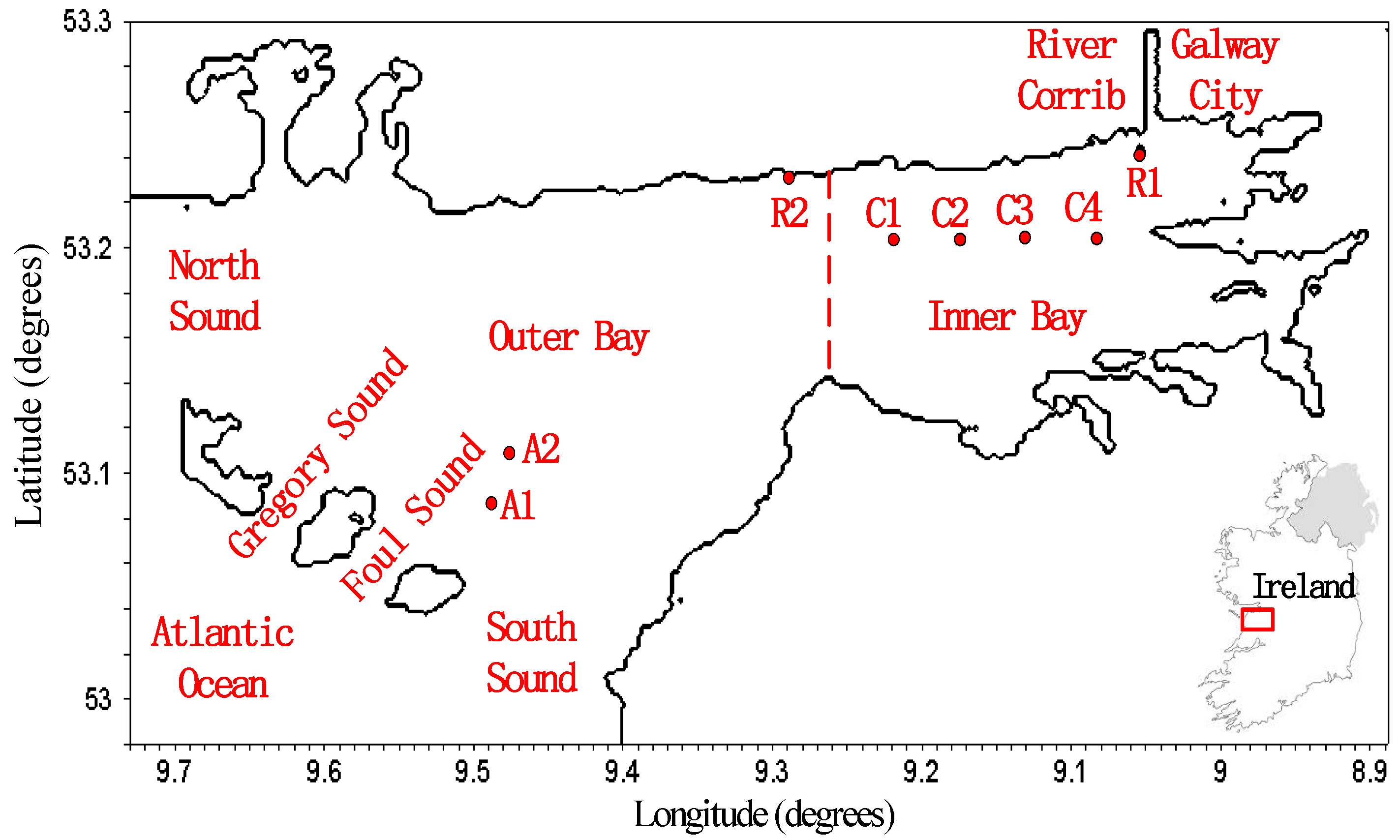
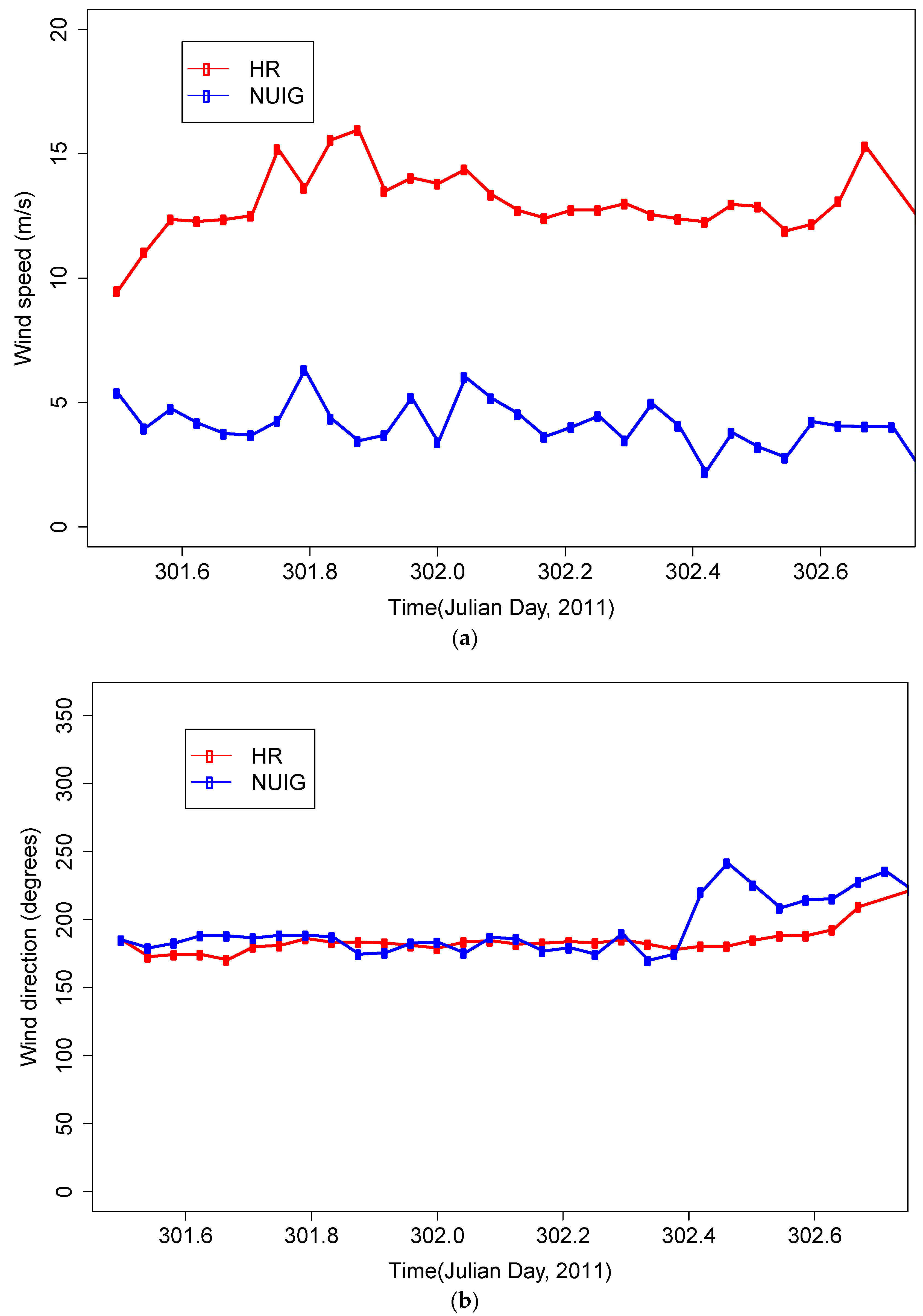




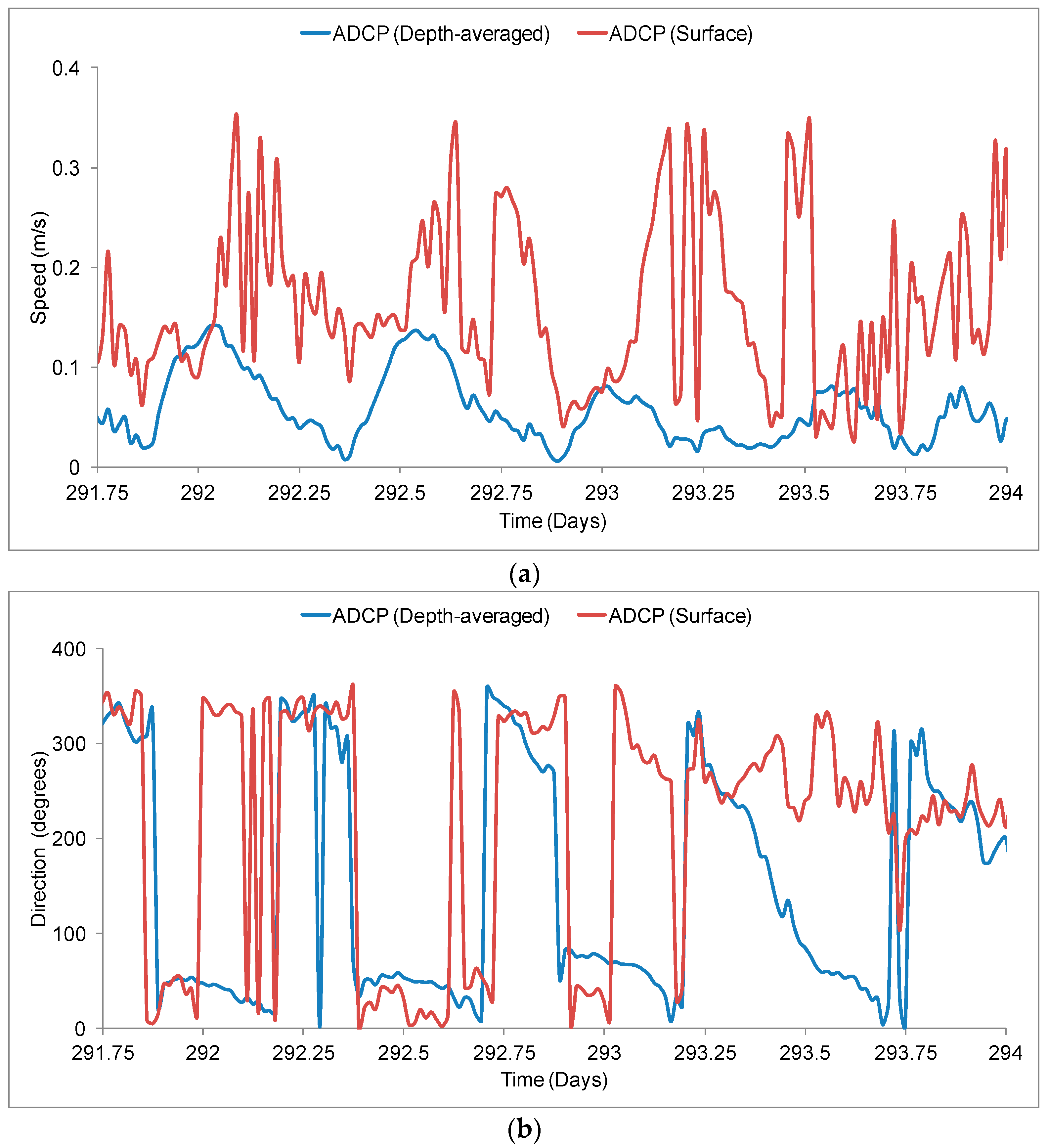
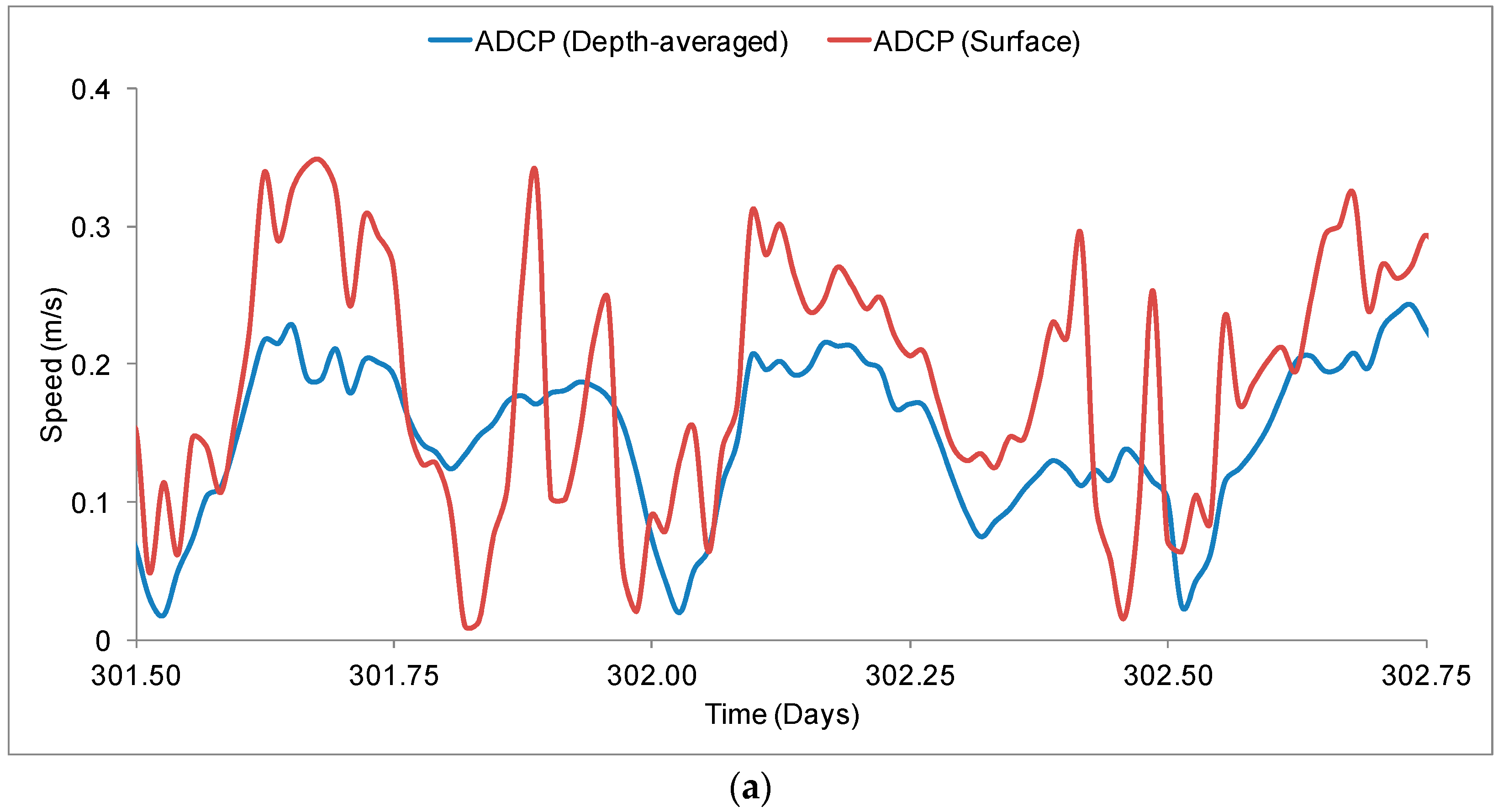
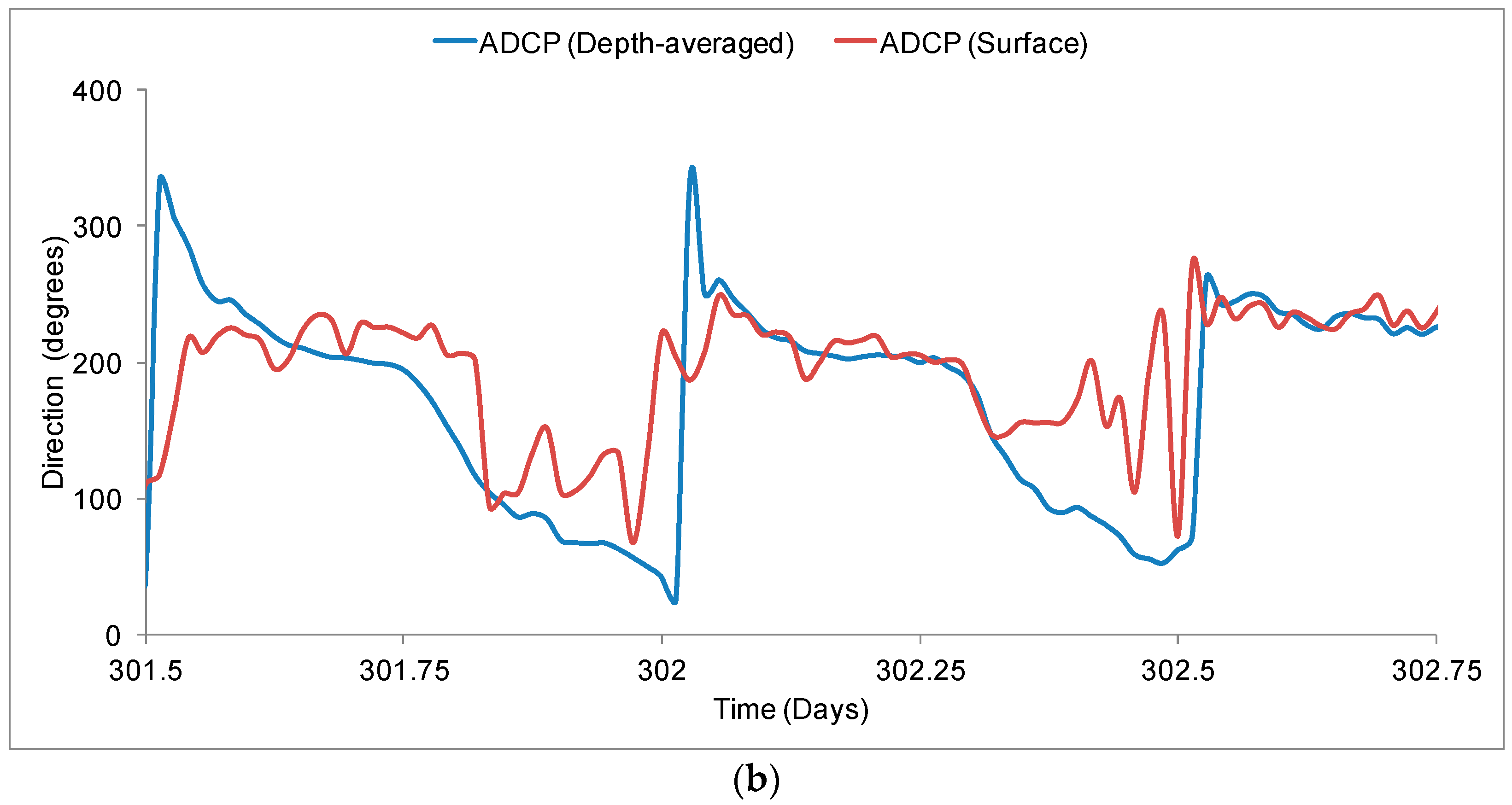
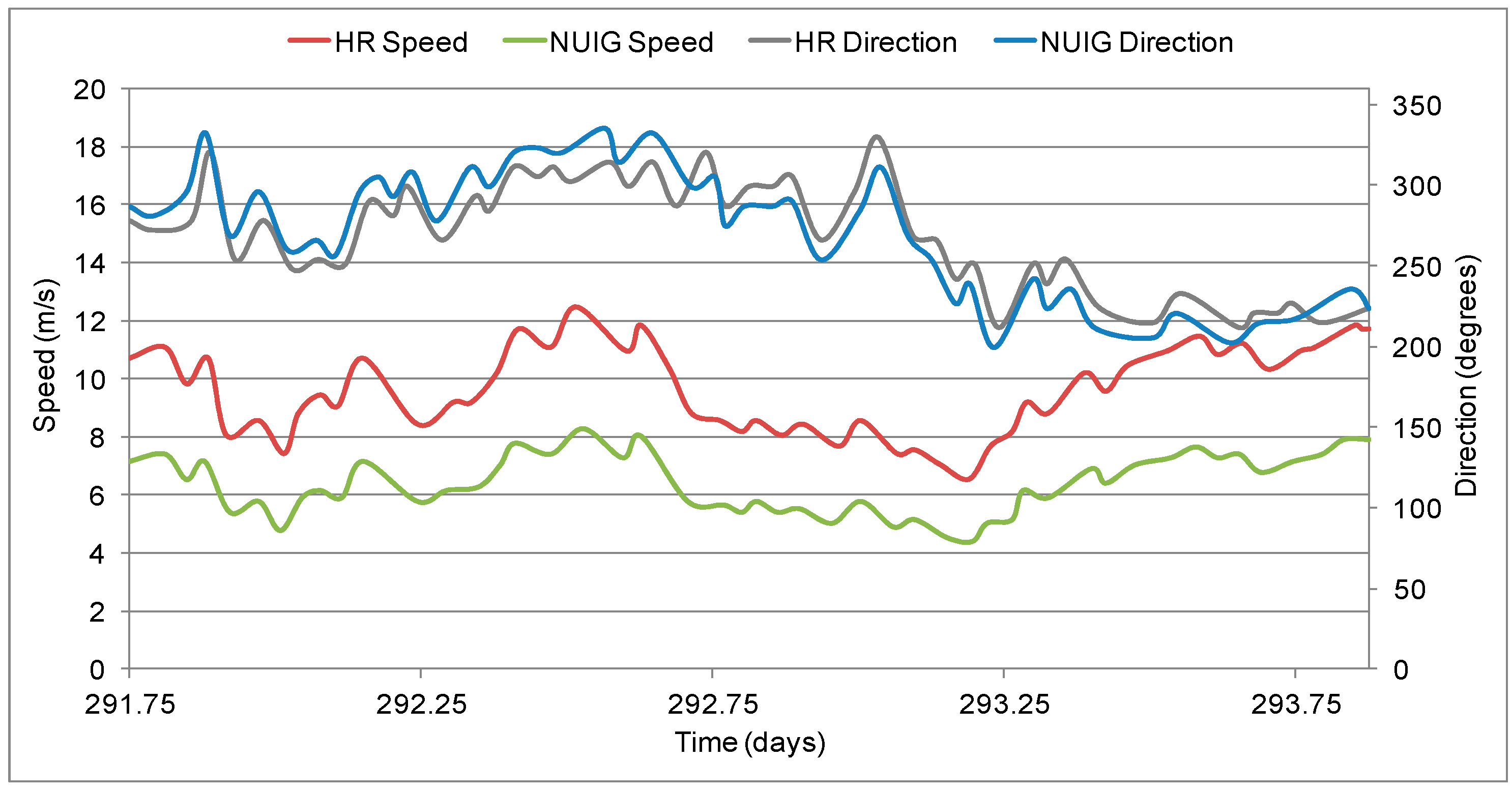
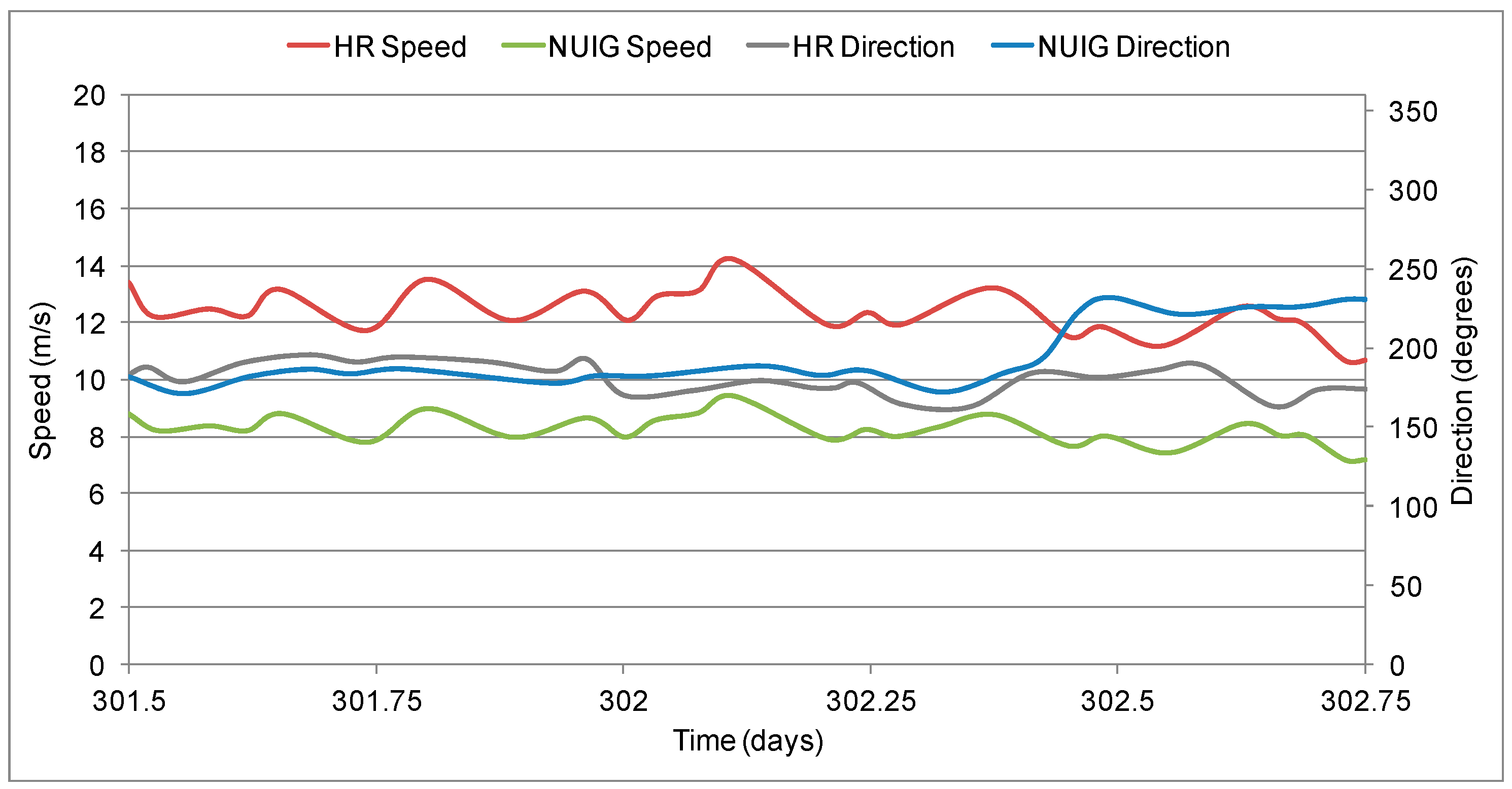

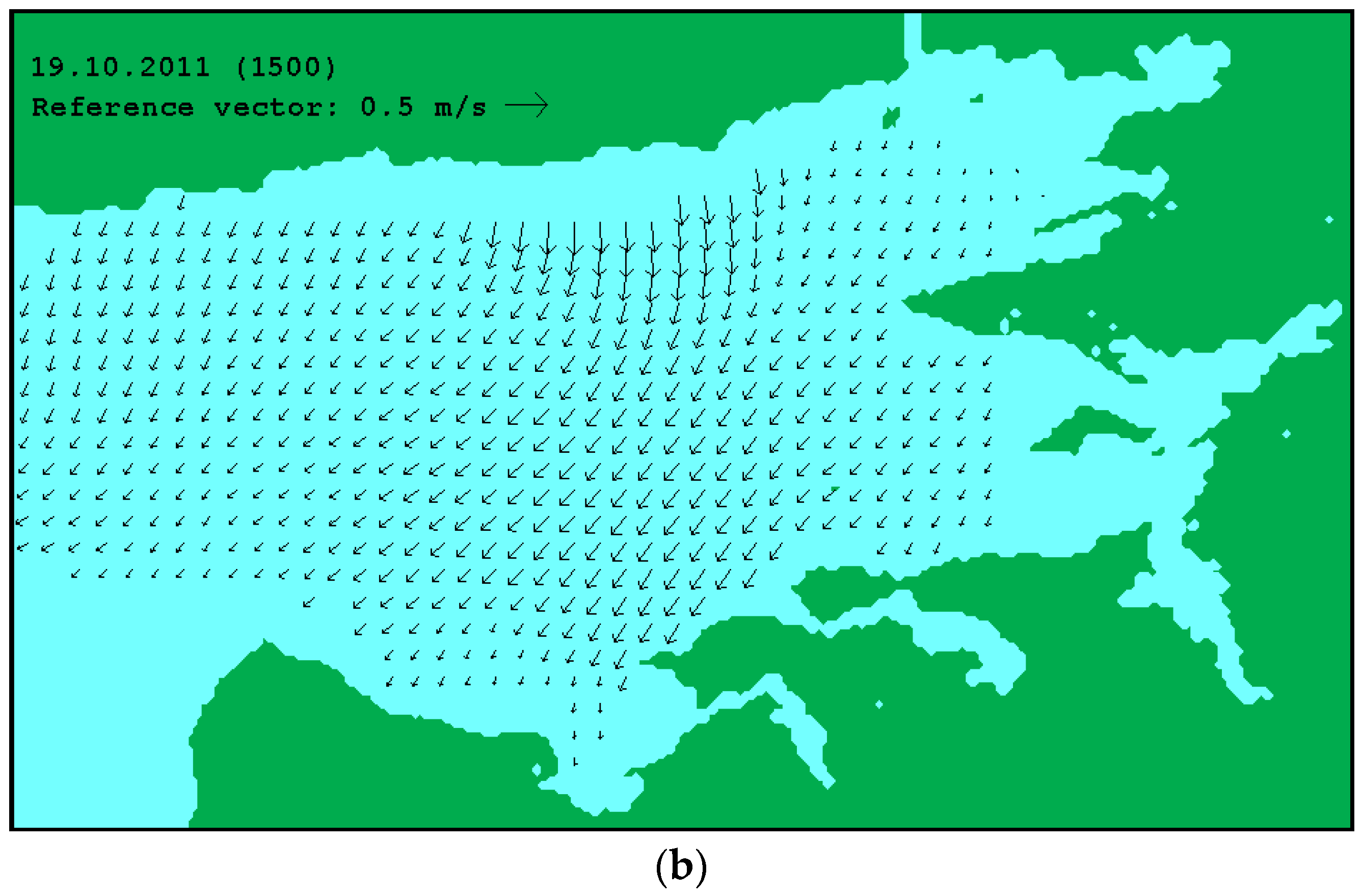
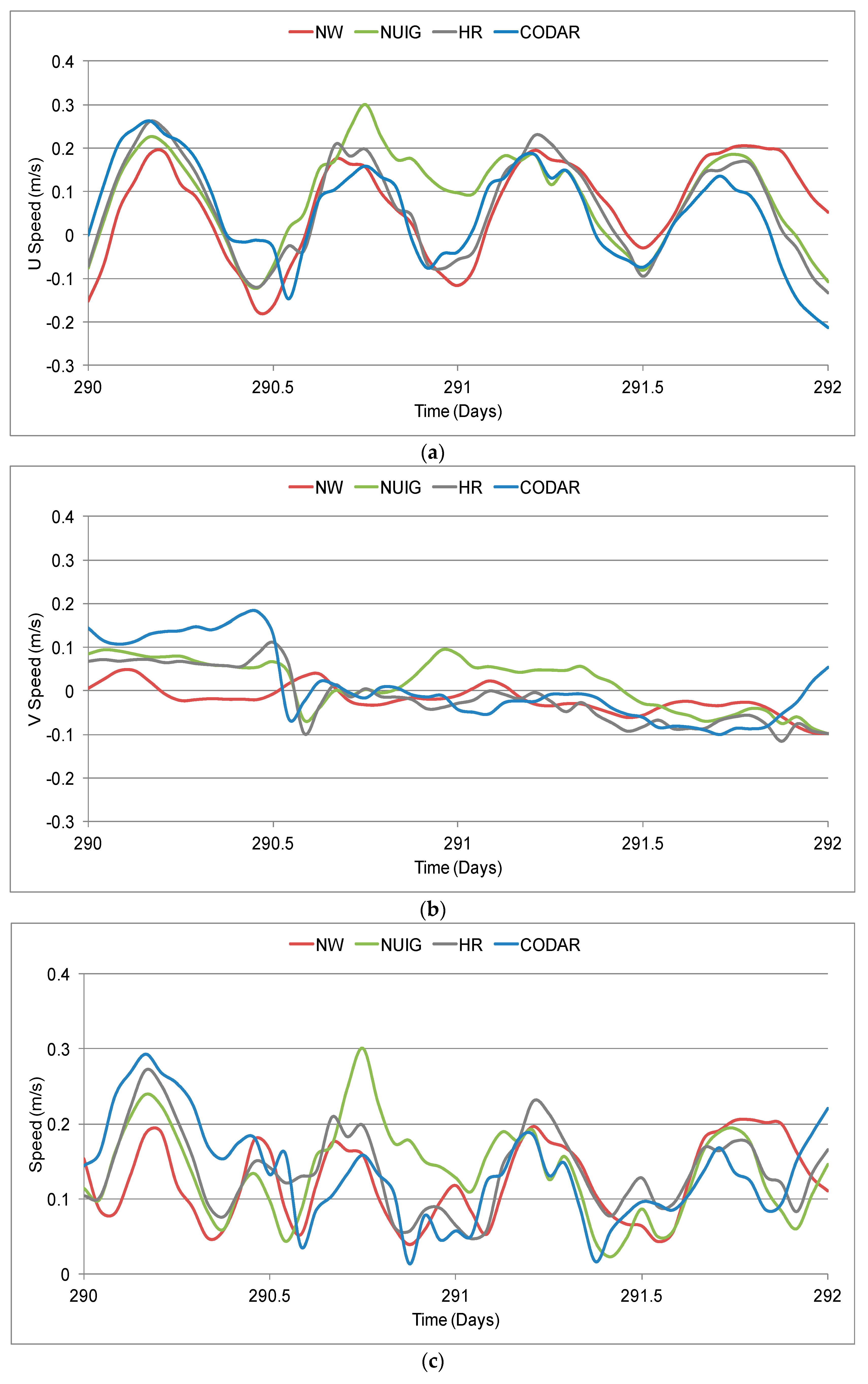

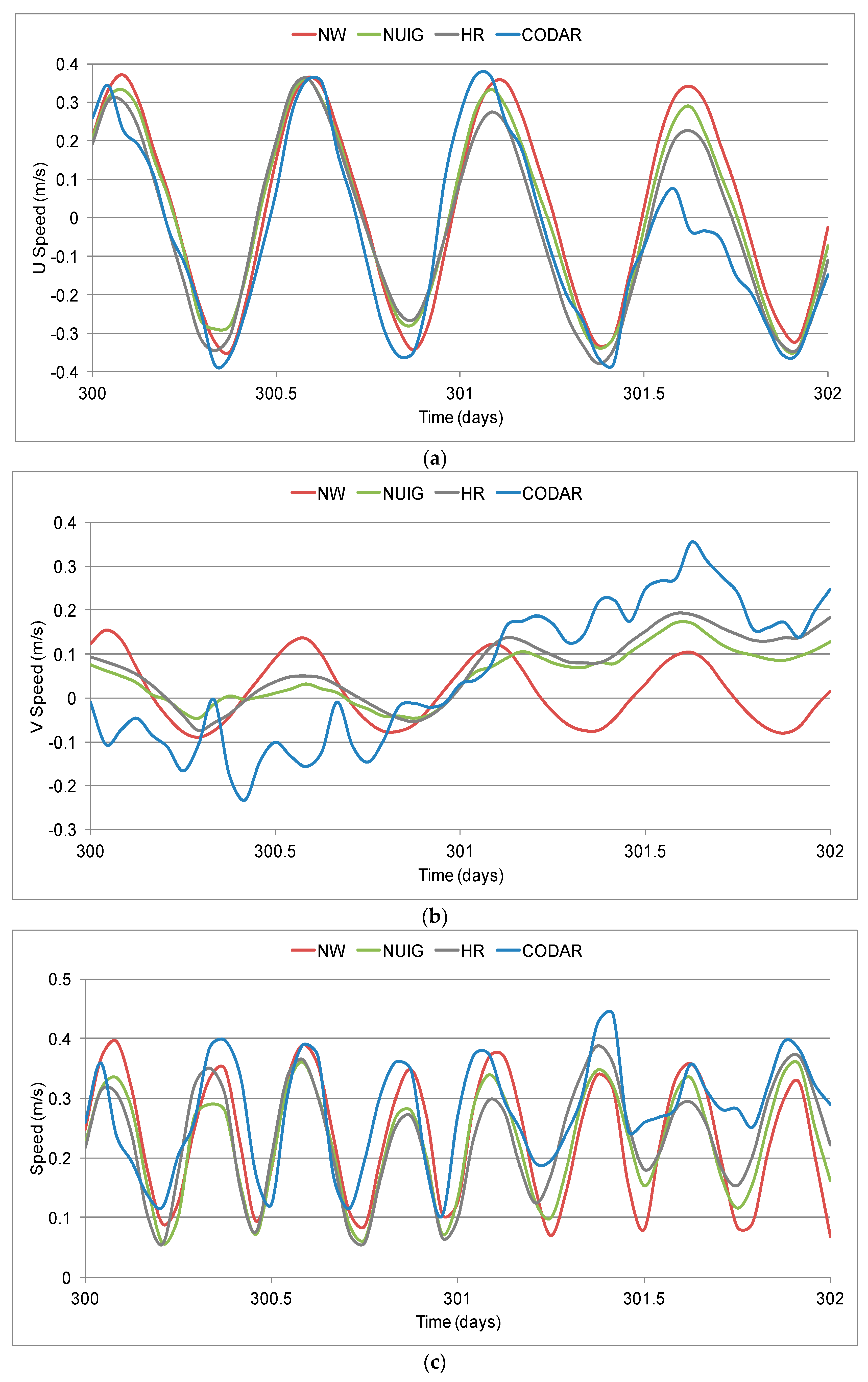

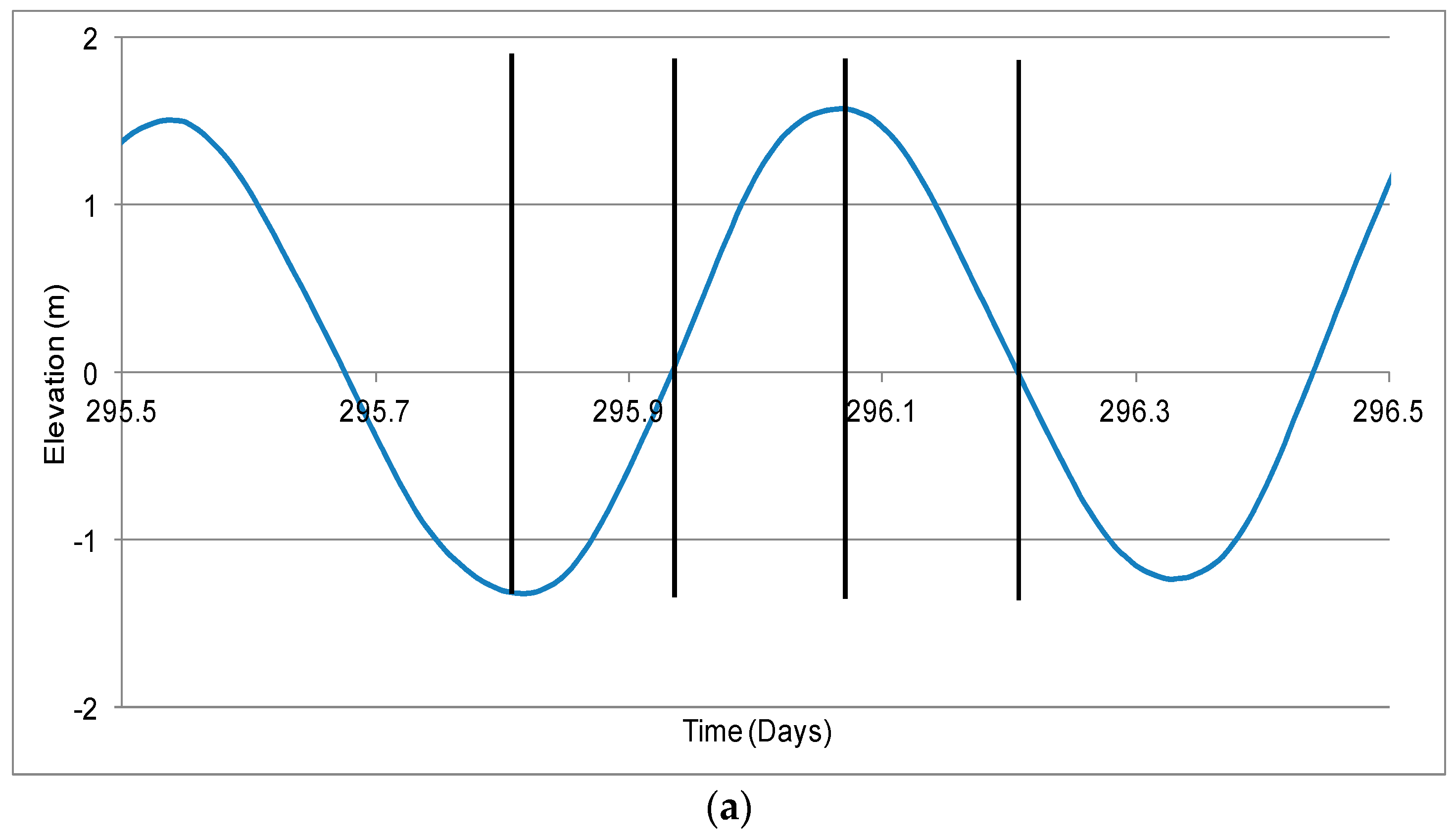
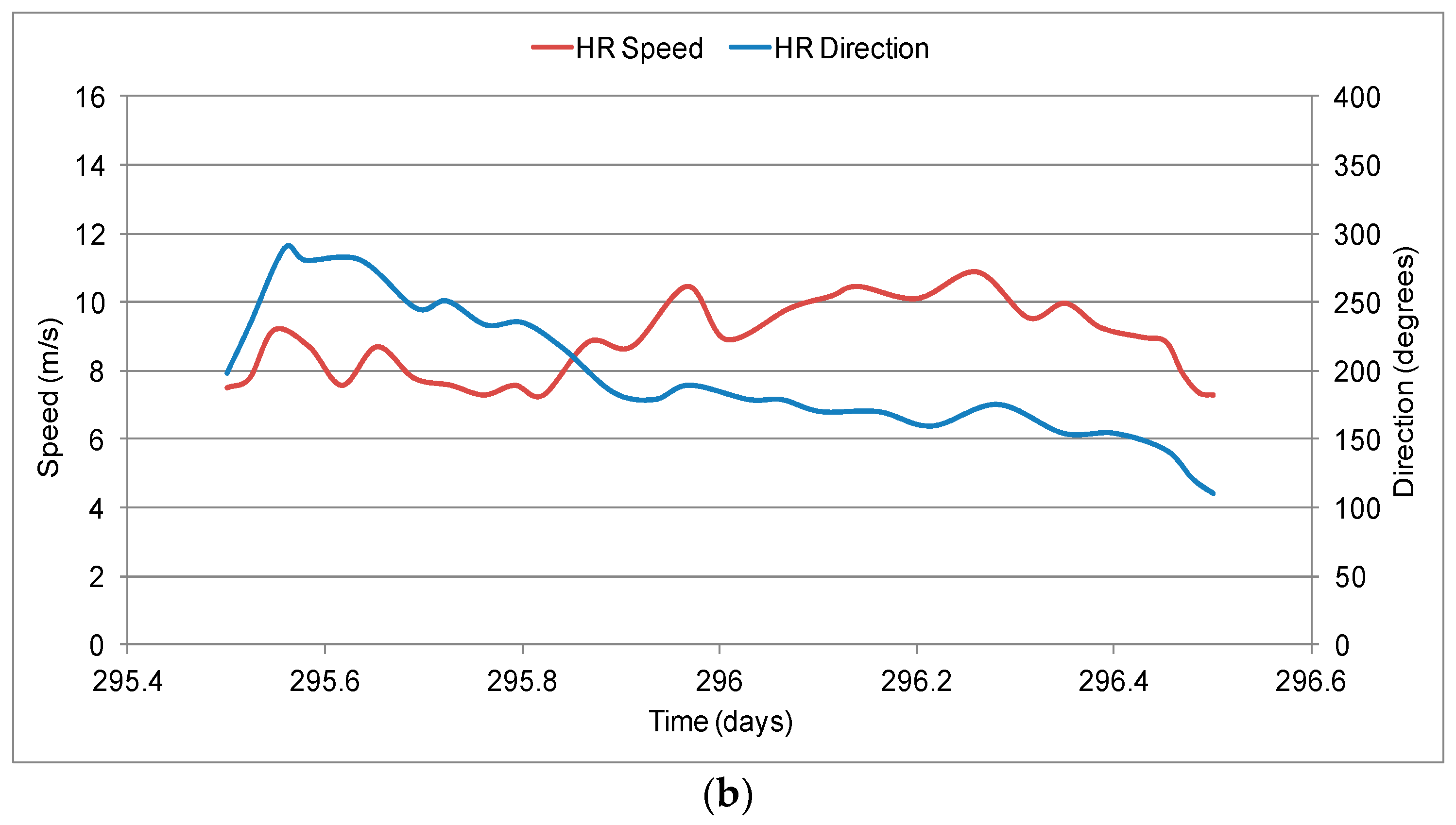
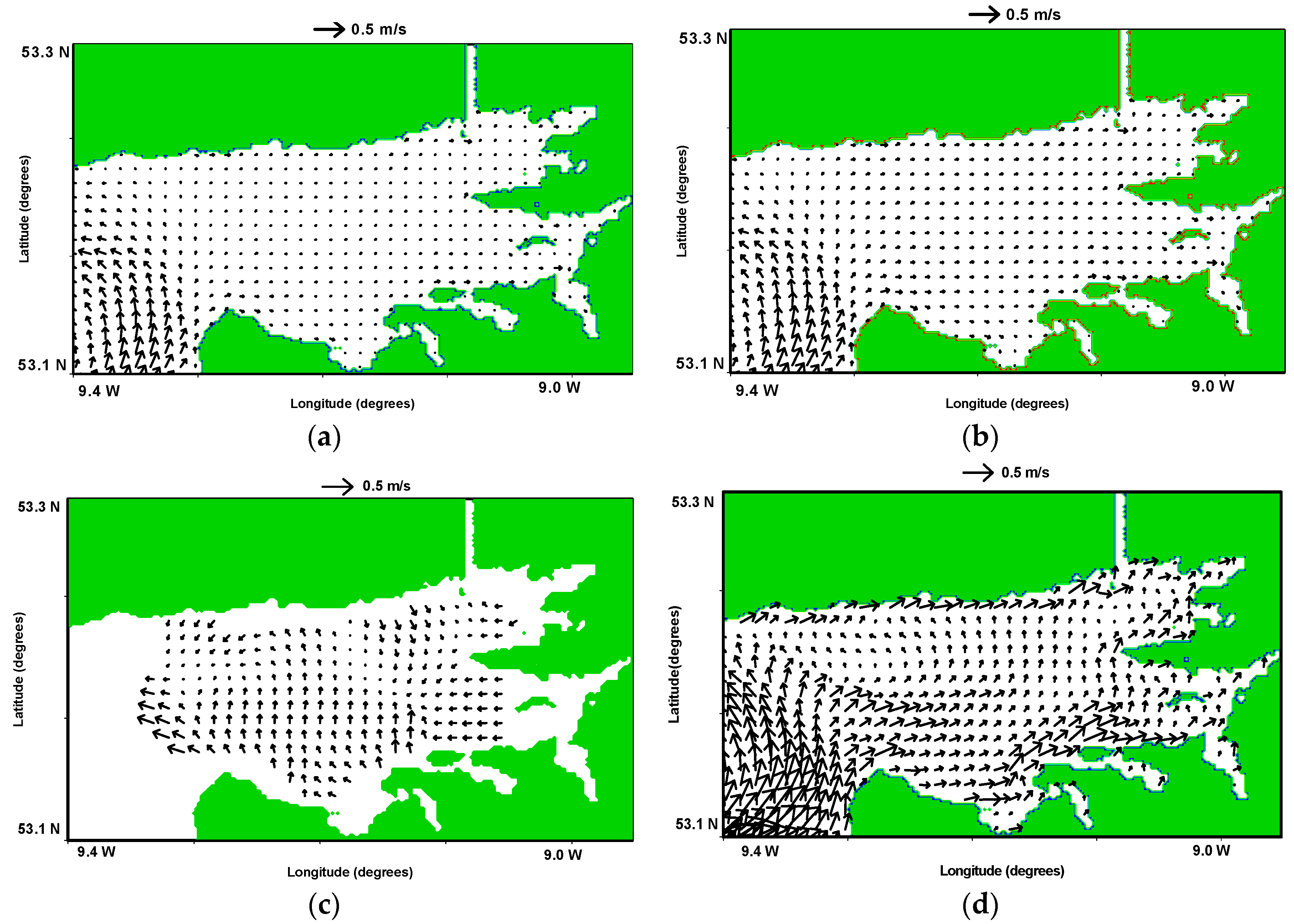

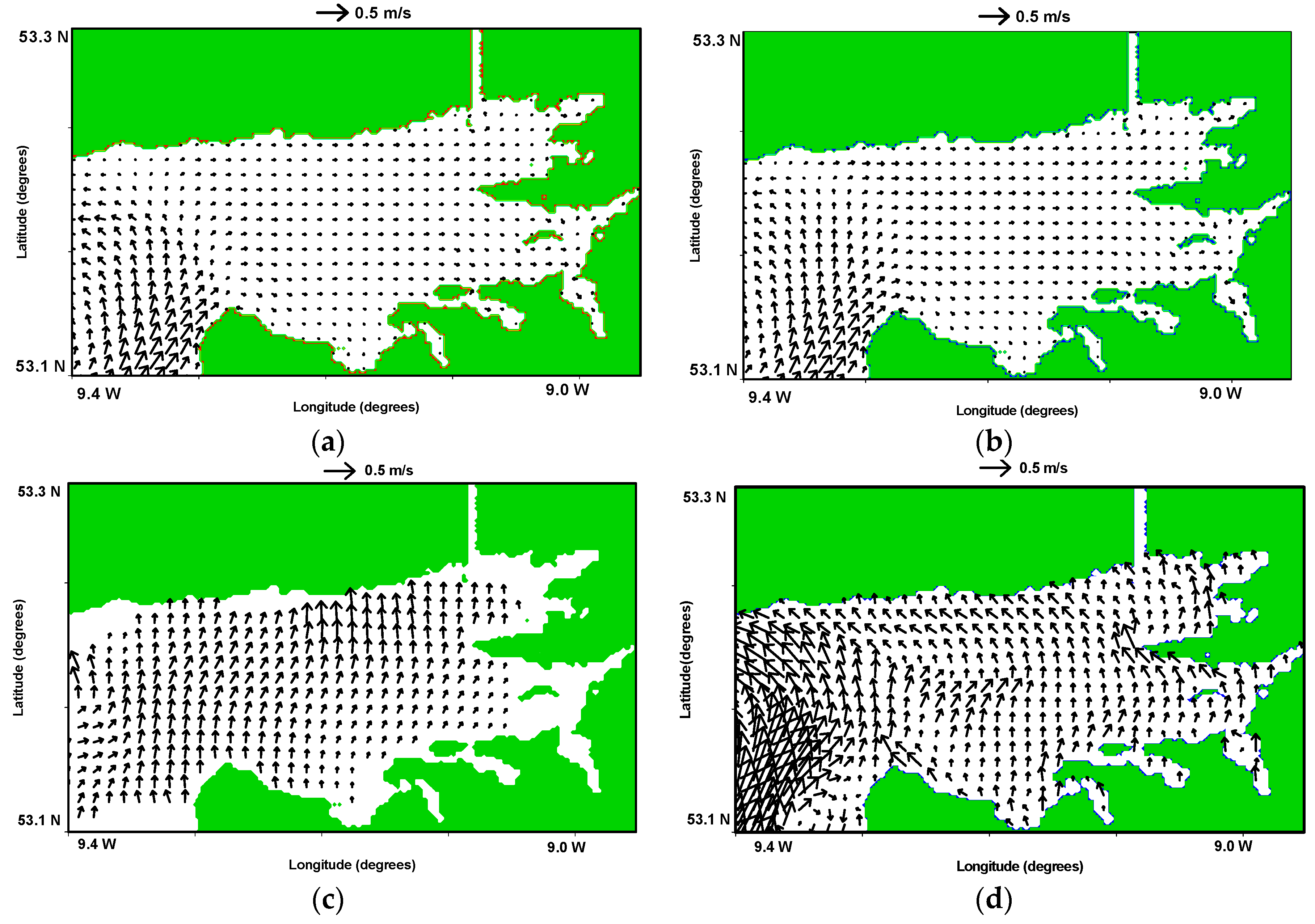
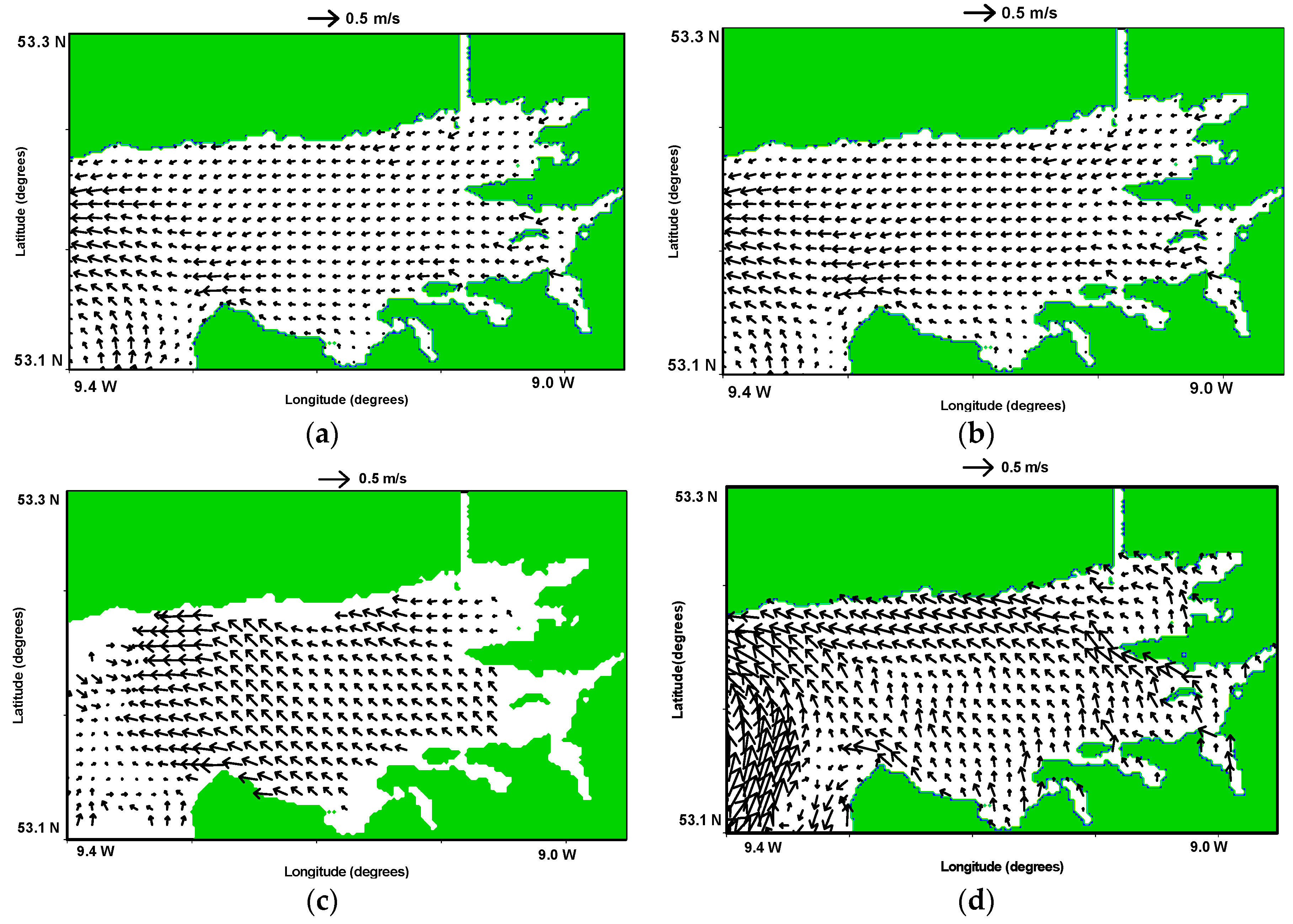
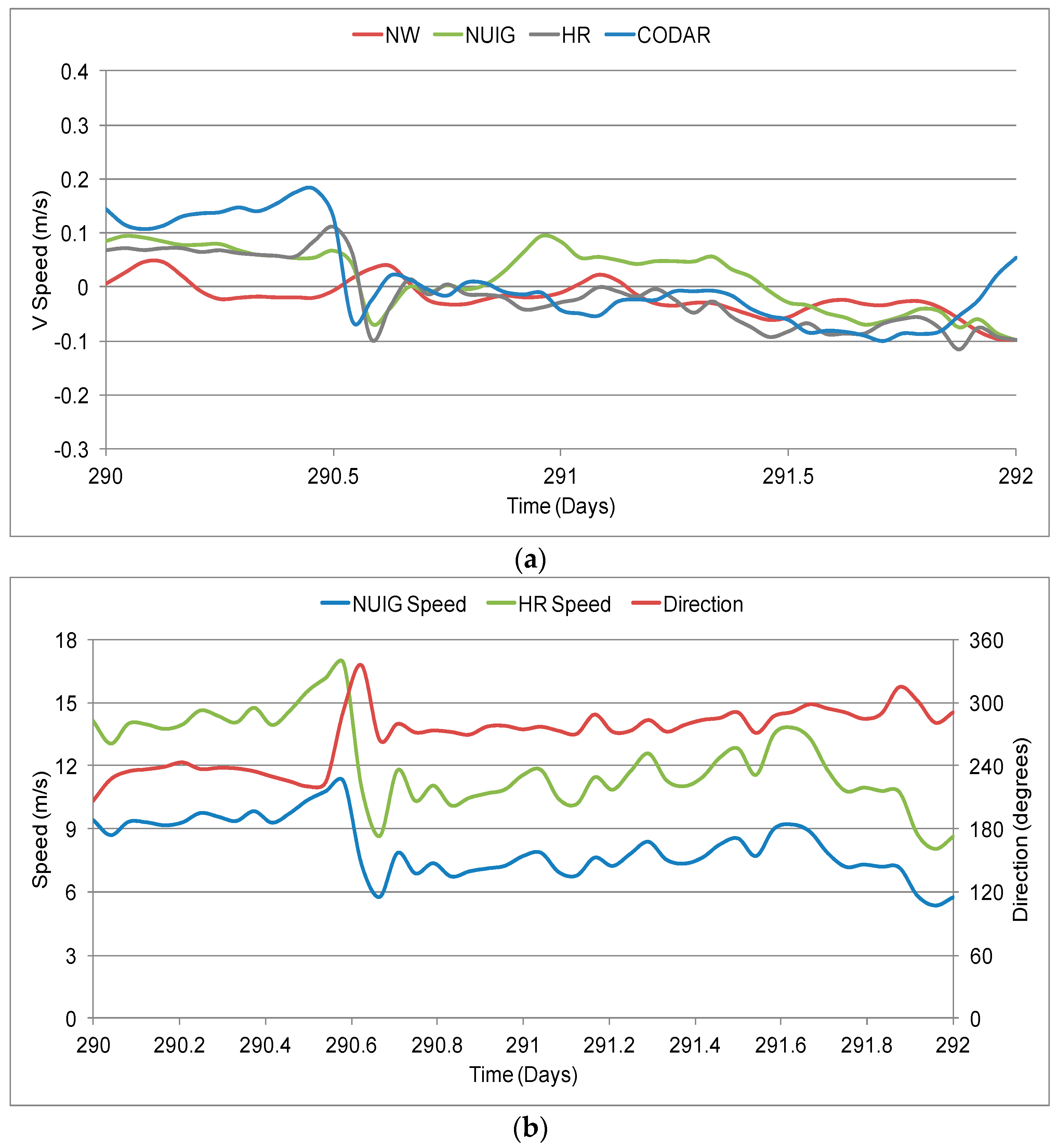
| Index | Period | Time | Duration (hours) |
|---|---|---|---|
| P1 | Period one | Julian Day 291 18:00 to Julian Day 294 00:00 | 55 |
| P2 | Period two | Julian Day 301 12:00 to Julian Day 302 17:00 | 29 |
| P3 | Period three | Julian Day 309 18:00 to Julian Day 312 00:00 | 55 |
| P4 | Period four | Julian Day 312 00:00 to Julian Day 314 06:00 | 55 |
| Variable | Standard Deviation | Mean Difference |
|---|---|---|
| Speed (m/s) | 1.4 | 7.4 |
| Direction (°) | 18.7 | 0.9 |
| Model | Wind Source Used |
|---|---|
| NW | No wind forcing |
| NUIG | Temporally varying but spatially non-varying measured onshore wind |
| HR | Temporally and spatially varying offshore wind forecast offshore wind |
| Period | Model | Location | RMSE (u, cm/s) | RMSE (v, cm/s) | RSQ (u) | RSQ (v) |
|---|---|---|---|---|---|---|
| P1 | NW | C3 | 11.24 | 8.63 | 0.25 | 0.08 |
| P1 | NUIG | C3 | 8.56 | 6.49 | 0.57 | 0.35 |
| P1 | HF | C3 | 5.64 | 5.57 | 0.76 | 0.66 |
| P3 | NW | C2 | 12.46 | 17.83 | 0.82 | 0.00 |
| P3 | NUIG | C2 | 9.87 | 10.95 | 0.87 | 0.74 |
| P3 | HF | C2 | 9.02 | 10.52 | 0.86 | 0.69 |
© 2017 by the authors. Licensee MDPI, Basel, Switzerland. This article is an open access article distributed under the terms and conditions of the Creative Commons Attribution (CC BY) license (http://creativecommons.org/licenses/by/4.0/).
Share and Cite
Ren, L.; Nagle, D.; Hartnett, M.; Nash, S. The Effect of Wind Forcing on Modeling Coastal Circulation at a Marine Renewable Test Site. Energies 2017, 10, 2114. https://doi.org/10.3390/en10122114
Ren L, Nagle D, Hartnett M, Nash S. The Effect of Wind Forcing on Modeling Coastal Circulation at a Marine Renewable Test Site. Energies. 2017; 10(12):2114. https://doi.org/10.3390/en10122114
Chicago/Turabian StyleRen, Lei, Diarmuid Nagle, Michael Hartnett, and Stephen Nash. 2017. "The Effect of Wind Forcing on Modeling Coastal Circulation at a Marine Renewable Test Site" Energies 10, no. 12: 2114. https://doi.org/10.3390/en10122114






